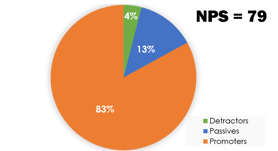In a seasoned corporate fitness program, sometimes it's hard to figure out where to look next for improvement in the services, staffing, or overall offering. In NIFS almost three decades of providing corporate fitness management services, we've continued to evolve our use of surveys well beyond the typical satisfaction ratings. Below are three tested survey styles that we use on a regular basis to improve our corporate fitness centers and ensure our staff are doing everything they can to sustain a positive and inviting fitness atmosphere for employees.
The New Member Experience Survey
We know that creating a positive and welcoming first experience for employees in corporate fitness is crucial to winning loyal members. And we value customer service skills in our staff as much as we value sound exercise science knowledge. In order to capture our staff's effectiveness at using strong customer-focused skills with new members, we began implementing a new member experience survey. We use the tool in a monthly welcome email with new members to get a better picture of any potential barriers members may experience as well as to better understand how well our staff are implementing expected procedures for orienting new members. Results from this survey offer strong talking points in semi-annual review discussions or more frequently if needed to both praise and correct staff, based on member feedback.
The Quality Assurance Surveys
When we contract with a business to provide fitness center management services, part of the package includes managing liability within the fitness environment. We have several components in our quality assurance program that support this activity, including a monthly emergency procedures survey which our managers fill out. It provides a nudge to ensure they're checking emergency equipment, stocking first aid kits, and documenting any missing or broken supplies in a timely fashion. We also have an annual risk management survey and a semi-annual emergency survey where staff work through emergency scenarios and take an emergency preparedness quiz.
The Satisfaction Survey (with a twist)
I suspect that most vendors like us provide a satisfaction survey to share with clients how the staff, services, and spaces are being received by their employees. It's foundational to measuring our commitment to the client; in fact, portions of our satisfaction survey sometimes translate into service level agreements between us and the client. We've made tweaks to our standard survey over the years, and we recently added a Net Promoter Score question as a new twist that provides us with more of an industry benchmark for the way our staff are connecting with members to build loyalty.

Even if you're unfamiliar with NPS, there's a good chance you've answered a product or service survey question that generated an NPS for the provider. It's usually worded to ask how likely you are to recommend X service/product to a friend and the answer is given on a 0-10 scale. The responses then are broken down into three categories:
- Detractors, rate their likelihood to recommend between a 0-6. They are considered likely to stop using your product/service and/or share negative feedback about your product/service.
- Passives, rate their experience as a 7-8. They’re neutral to your brand; they might continue to use your product/service, but they aren’t likely to invite others into the fold.
- Promoters, rate their experience as a 9-10 and they are considered evangelists for whatever you’re selling; they LOVE you and will tell others about how great you are.
The industry average NPS for fitness centers as tracked by the International Health, Racquet and Sportsclub association (IHRSA) is 43. That score includes commercial gyms, so it’s not quite apples to apples, but we are talking about a very similar scope of services where members are entrusting their physical health to the fitness center staff and carving out their very precious personal time to spend time at the gym. Since we added an NPS question to our survey over the last few years, we have far exceeded that industry benchmark and we are regularly looking at strategies to continue growing member loyalty.
This overview provides a good snapshot of the types of information we gather through surveys, but I haven't touched on how we use the survey responses to coach our staff, improve our client relationships and manage customer liability. To dig more deeply into these topics, grab our white paper.



